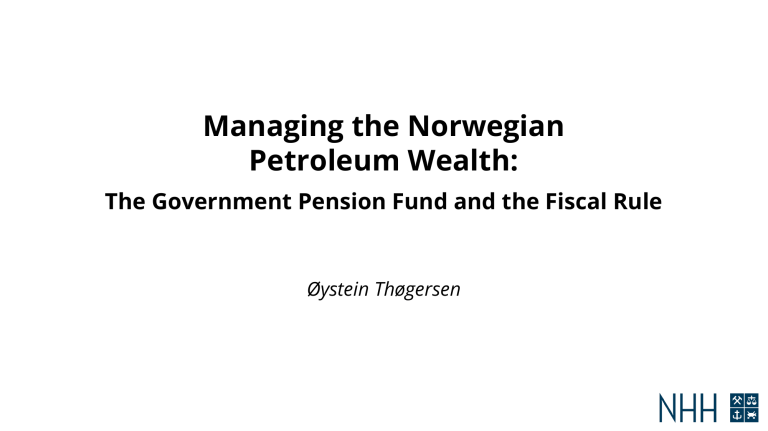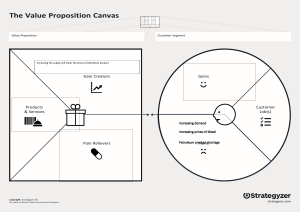
Managing the Norwegian Petroleum Wealth: The Government Pension Fund and the Fiscal Rule Øystein Thøgersen Reading • Gjedrem, S. and Ø. Thøgersen (2017): "A fiscal rule for an oil-rich economy: The Norwegian experience in light of theoretical insights”, in Finance in Society, Cappelen Damm Akademisk, 69-92. 1. Point of departure: The petroleum wealth • Petroleum wealth: The value of the petroleum resources in the ground. • The petroleum wealth can be estimated by means of a simple NPV calculation: • But, recall, a NPV calculation does not capture the potential value of flexible production strategies, i.e., the real option value of the resources. Calculating the petroleum wealth • Underlying assumptions: • Resource volumes, oil and gas in each specific field • Existing fields • Future fields • Production trajectories for oil and gas in each field • Price paths for oil and gas (gas prices are field specific) • Operating costs, investments • Discount rate (risk adjusted?) • Clearly: A lot of highly uncertain assumptions! Calculating the petroleum wealth • “Semi-official” wealth estimates: • Estimates from the 1980s (estimates from SSB, 7% discount rate, 1986 NOK) • • 1981: PW=2273 billions, 1988: 413 billions. Since the 1990s estimates have been more stable (3% discounting, nominal NOK, from Ministry of Finance) • NB 2019: PW = 6000 billions, public share 5100 billions • NB 2020: PW = 5700 billions, public share 4900 billions • NB 2021: PW = 5600 billions, public share 4500 billions • (and, at the same time, the financial Petroleum Fund, “GPFG“, is estimated to 10300 billions at the start of year 2021). • Why is the public share so high? • Taxation (special tax system in the petroleum sector) • Direct public involvement Oil price volatility Uncertainty in the estimates Estimated oil price. 2013 NOK/bbl. From PW in the ground to financial wealth in the GPFG Managing the petroleum wealth – big issues Four major issues for the macroeconomic development: 1. Decisions on the production levels over time 2. Management of risk exposure 3. Sectoral adjustments (fear of Dutch disease?) 4. Optimal intertemporal spending decisions • Objective: Achieve smooth spending over a very long, maybe infinite, horizon 2. Key institutions 2.1 The Government Pension Fund Global • The GPFG was established in 1990, first deposit 1996 • …is not a real pension fund… • A public endowment fund, a big SWF • Name of fund hints at political ambitions to secure welfare in the long run… • Fund managed by Norges Bank, the Central Bank of Norway, • Norges Bank Investment Management (NBIM) • Ministry of Finance specifies the “benchmark” of the fund, NBIM has a certain “risk budget” allowing them to take active bets in the markets. • Benchmark: 70% stocks, 30% bonds and real estate • Market risks, operational risks, political risks GPFG: Values in billions of NOK Volatility in the return of the fund... …and volatility in excess returns Rebalancing 2.2 The semi-official fiscal rule • Large and varying government petroleum revenues and the fiscal policy strategy • Short/intermediate run effects of fiscal policy on the business cycle • Long run intertemporal/intergenerational distribution of tax burdens and welfare • Intertemporal pooling of oil price risk • The fiscal rule • Spending, in a normal year, should amount to the expected long run return on the GPFG • Expected long run return on the GPFG was originally estimated to 4% real return. This figure was revised down to 3% in 2017 • Spending is measured by the ”structural non-oil deficit”, i.e., the automatic stabilizers of fiscal policy can work freely Fiscal rule – spending profiles in theory Structural non-oil deficit – Fiscal budget • Non-oil deficit: • Gap between public expenditures and public income (tax revenues etc.) except net cash flow from petroleum sector • Fiscal rule: In a normal year, i.e., “economy on trend path,” spending of petroleum revenues should equal non-oil deficit • Spending should equal structural non-oil deficit: • Economy may be below or above trend • Tax revenues highly sensitive to business cycle • Public transfers (unemployment benefits etc.) highly sensitive to cycle • Without any adjustments of non-oil deficit, fiscal rule procyclical • Structural non-oil deficit: Components in fiscal budget adjusted as if the economy was operating on trend. In for example a downturn, tax income adjusted upwards and unemployment benefits downwards • Consequence: Automatic stabilizers can work freely The fiscal rule: Illustrating uncertainty in old 4% path Source: NOU 2015:9 Fiscal rule: From 4% path to 3% path... Source: NB 2017 Source: NB 2020 Variations in the estimated 4% and 3% paths Variations in 4% path Uncertainty in 3% path Source: Stm 14/2021 Source: NOU 2015:9 Fiscal budget for 2021 Spending of petroleum revenues = Structural non-oil deficit The fiscal impulse: The change in the structural non-oil deficit, as per cent of trend GDP for Mainland Norway Updated prospects 2021: Spending has peaked, expect zero impulses ahead Source: Stm 14/2021 Public expenditures as a share of GDP Appendix: Tax-smoothing model Tax smoothing model vs. fiscal rule See Gjedrem & Thøgersen (2017) Minimize total tax burden with respect to Tt Stationary economy A growing economy


